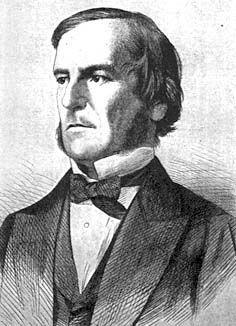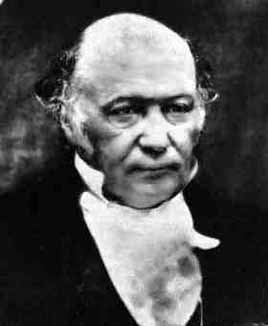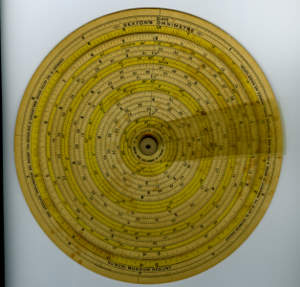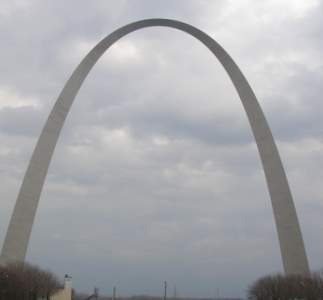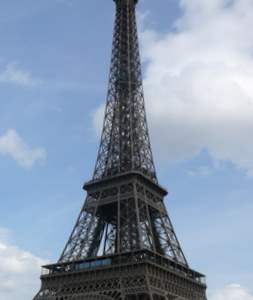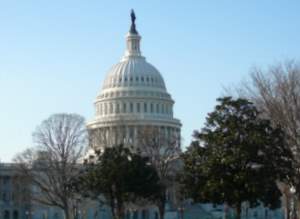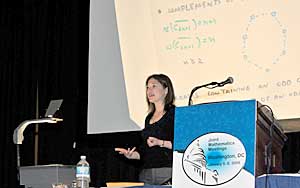
Invited Addresses, Sessions, and Other Activities
Math Mistakes that Make the News, Heather A. Lewis (Nazareth College) ---Claudia Clark Boole and Hamilton: An Unanswered Question, Charlotte K. Simmons (University of Central Oklahoma)
Simmons began her presentation with a brief biography of mathematicians William Hamilton (above, right) and George Boole (above, left). On the surface, the two men were very different. Hamilton began preparing for a career at Trinity College at the age of three, and had completed his first paper while still an undergraduate. Boole, on the other hand, was almost entirely self-taught. The first paper he submitted to the Royal Society was awarded the first gold medal in mathematics presented by that society, after nearly being rejected because the author was poor and unknown. However, Simmons notes, the two had much in common: They were both highly original mathematicians working in related fields; they lived within 200 miles of each other for several years; and they shared many views. In spite of this, the two had little to do with each other. Simmons describes an attempt Boole made to get Hamilton’s opinion on his work Laws of Thought: After receiving no reply for a year, Boole’s second letter received a terse acknowledgement, a response that was highly unusual for the normally obliging Hamilton. The lack of a relationship between the two men remains a mystery. ---Claudia Clark
Geometry from Data Points ---Allyn Jackson
MAA Invited Address: Stacking Bricks and Stoning Crows, Peter Winkler (Dartmouth College) Winkler then turned to a related problem: what is the optimal overhang of a stack of n bricks of length 1, assuming no friction and only vertical forces? Starting with the classical solution— harmonic stacks, which can achieve a maximum overhang of 1/2 ln n—he displayed various balanced stacks that show increasingly greater overhang. These include the “3-diamond” and “5-diamond” structures as well as “spinal” stacks, which have an overhang of order ln n, and are the optimal structure for stacks containing 3 to 19 bricks. But the best overhang is achieved by the brick-wall “parabolic,” “vase,” and “oil lamp” constructions: each has an overhang of order n1/3, an exponential improvement over the spinal stack overhang! Using an argument that is based on the idea that stacking bricks is like stoning crows, Winkler and his colleagues were able to prove that a stack of n bricks cannot overhang by more than an order of n1/3: “it takes order n3 bricks to make the stack lean out to n.” To read more about the ideas presented in this lecture, see the papers Overhang by Mike Paterson and Uri Zwick and Maximum Overhang by Mike Paterson, Yuval Peres, Mikkel Thorup, Peter Winkler, and Uri Zwick. You may also look for them in a future edition of American Mathematical Monthly. ---Claudia Clark
MAA Special Film Presentation: The Story of Maths, Part I: The Language of the Universe, Robin Wilson (The Open University) Moving on to Damascus, we learn that the ancient Babylonians, like the Egyptians, focused on solving practical problems (such as calculating the area of a piece of land), evidenced by the clay tablet records that have been found. Unlike the Egyptians (whose number system was based on the decimal system), they used a base-60 number system: to count they used 12 knuckles on one hand and 5 fingers on the other. Also unlike the Egyptians, their number system recognized place value. This led them to invent a sign that indicated an empty place in the middle of a number, although, du Sautoy notes, “it would be over 1000 years before this little placeholder would become a number in its own right.” There is also evidence that they had some understanding of the Pythagorean relationship, 1000 years before Pythagoras. In Greece, du Sautoy offers some of the Greeks contributions to mathematics, the greatest of which, he says, is the “power of proof.” He discusses the legend of Pythagoras, who is credited, “rightly or wrongly, with beginning the transformation from mathematics as a tool for accounting to the analytic subject we recognize today.” He also presents a geometric proof of the Pythagorean Theorem, and describes a legend surrounding the discovery (and tragic consequences to one eager discoverer) of irrational numbers. He finishes this program speaking about Plato and the five solids, Euclid and the contents of The Elements, and introduces some of Archimedes' work, including his method for calculating the volume of solid objects. The Open University has posted more information about the series, and the 10-week course designed to accompany it. ---Claudia Clark Summaries of three talks in the AMS-MAA Special Session on History of Mathematics:
Mrs. Bean’s Young Ladies: Mathematics Education in Early Modern England, Kathryn James (Beinecke Library, Yale University) Toward the end of her presentation, James listed five conclusions that she has drawn about mathematics education in early modern England from these notebooks:
Several pages from the first notebook, entitled “Mary Sarjent her book scholler to Eliz Bean Mrs. in the art of writing and arithmetick,” are available at the Beinecke Library website. ---Claudia Clark Computing Devices, Mathematics Education and Mathematics – Sexton’s Omnimetre in Its Time, Peggy Aldrich Kidwell (National Museum of American History, Smithsonian Institution)
As part of her presentation on mathematical aids and their impact on mathematics, engineering, and education, Peggy Kidwell discussed a type of circular slide rule known as Sexton’s Omnimetre. This instrument was invented by Albert Sexton of Philadelphia and copyrighted in 1898. It could be used to perform a host of arithmetic and trigonometric operations, including multiplication, division, logarithms, squares and cubes of numbers, sines, tangents, secants, and versed sines. At the time of its invention, Kidwell noted, “the principle of the slide rule had been known for some 250 years.” Indeed, Kidwell presented images of several rules created for specialized tasks, such as calculating the volume of barrels, and therefore, excise taxes. Sexton’s decision to invent this slide rule was instigated by his reading of an article in the Journal of the Franklin Institute, in which the author referred to circular slide rules and encouraged the use of slide rules by young engineers. Sexton decided to invent a circular slide rule that would be less expensive than existing models and be able to perform more calculations. Six models of the omnimetre were offered, differing in size, material, and types of calculations performed. The Smithsonian’s omnimetre is one of the “improved third edition,” seemingly the “only edition to sell in later years.” It was owned by George Dankers, “a naval architect, [who] acquired his omnimetre when he joined the U.S. Navy’s Preliminary Ship Design Branch in 1938. He used it for thirty years, in the design of ships from PT boats to aircraft carriers.” The last advertisement for an omnimetre that Kidwell has found is from 1958, and slide rules stopped being manufactured in the mid-1970s with the introduction of the handheld electronic calculator. To learn more about the Mathematical Collection at the Smithsonian Institution, read “Mathematical Treasures of the Smithsonian Institution” by Allyn Jackson, Notices (May 1999). ---Claudia Clark
Theology, or Mathematics? ---Allyn Jackson
MAA Invited Address: Geometreks, Ivars Peterson (MAA)
Promising that “this presentation is about seeing—looking at things in a variety of different ways,” Ivars Peterson spent the next 45 minutes identifying the mathematics in well over 100 images, many from art and architecture, and many from around Washington D.C. He began with tilings, including a convex pentagonal tiling that appears on the floor of the front hallway of the Mathematical Association of America headquarters in Washington. He showed several examples of symmetry, including a skylight with 18-fold symmetry in the conference hotel. Examples of curves followed, including the St. Louis arch (an inverted catenary) and the Eiffel Tower, which, according to one source, has the shape of “one exponential function for the lower part and another exponential function for the upper part.”
Peterson also presented images that illustrated statistical concepts, such as the distribution of hand marks along a 19-degree vertical corner of the National Gallery of Art’s East Building. He showed works of art that were inspired by different numbers—pi and binary numbers—as well as sequences of numbers, including the Fibonacci numbers. The audience saw the influence of combinatorics in artist Sol LeWitt’s etching “Straight Lines in Four Directions All Their Possible Combinations” and his incomplete open cube sculptures. These were followed by more sculptures, built from shapes that included tetrahedrons and möbius strips. The presentation ended at the MAA headquarters with a discussion of Helaman Ferguson’s beautiful Umbilic Torus sculpture. Peterson has posted images that appeared in the presentation. ---Claudia Clark
Why Politics Matters A highlight of the end of the Joint Meetings was a panel called "Mathematics and Public Policy", organized by the MAA. Although some participants had left the meetings and those who remained were tired out, the panel drew a sizable audience. It was organized by Philippe Tondeur, professor emeritus at the University of Illinois at Urbana-Champaign and former director of the Division of Mathematical Sciences (DMS) at the National Science Foundation. Tondeur took advantage of the location of the meeting in Washington, DC, to invite two members of Congress, Vernon Ehlers of Michigan and Jerry McNerney of California, as well was Daniel Ullman of George Washington University, who recently served as an AMS Congressional Fellow for one year (as often happens with busy congressmen, Ehlers was unable to attend). McNerney, the only Ph.D. mathematician in Congress, led off the panel by describing his own background and what a big change it was for him to enter politics. Rather than rational argument, what matters most in politics, he said, is who can intimidate others, who is the most aggressive, who has the most seniority, etc. And yet, political decisions are too important to ignore, and the disinterested viewpoint of mathematicians is very much needed. "We want people who can look at a problem without the trappings of partisanship," he said. In discussing education, McNerney noted that although young people recognize the importance of science and are concerned about issues like global warming, many college students major in areas like political science or communications. A big challenge, he said, is to encourage young people to look at mathematics and science as inspiring and as offering excellent, interesting careers. The second speaker was Douglas Arnold of the University of Minnesota, who recently finished a term as director of the Institute for Mathematics and its Applications, and is beginning a term as SIAM president. Arnold looked back on the DMS "Odom Report", which appeared ten years ago. This hard-hitting report argued for increased federal support for mathematics and encouraged mathematicians to reach out to other disciplines. Arnold concluded that, in the ten years since the appearance of the Odom Report, a lot of progress has been made on both fronts. In particular, he noted how different the Joint Mathematics Meetings are than they were ten years ago---there are many more sessions on topics at the interface of mathematics and other sciences, including sessions on major challenges like climate change, computation, and energy. "Our community has been very responsive to moving in interdisciplinary directions," he concluded. He also found that core funding at the DMS had risen substantially in the past ten years. As the final speaker, Ullman noted that when policy issues arise, mathematicians typically focus on one question: How much money are we getting from the government? In fact, he argued, mathematicians need to take a different approach and put the emphasis on showing policymakers that mathematics is important in addressing national needs. "People who believe their work has no connection to the human condition should not expect funding," Ullman said. But he also noted that even very esoteric areas of mathematics are connected to problems people care about, and mathematicians need to illuminate these connections. ---Allyn Jackson
Coverage of the meeting has appeared in Slate, "Of the Algorithms, by the Algorithms, for the Algorithms" (the redistricting problem), by Chris Wilson; two articles in Science News, "Mathematicians show how beetles can share a niche," by Patrick Barry, and "When math and art collide," by Julie Rehmeyer; and in Nature News, "Fighting cholera by the numbers," by Roberta Kwok. |


